How a salvage crew took Captain John’s on one last voyage
Wayne Elliott wanted to give Captain John’s a dignified death. In his 40-year career, the senior salvage master with Marine Recycling Corporation has steered more than 120 vessels to safe, environmentally friendly retirement. “I have an emotional time with all of them, to tell you the truth,” he said. “I love the ships. But I also love what we do. I’m proud of what we do. It’s not respecting the ship to let it sink in dock somewhere.” Were it not for him, Ivan “John” Letnik’s floating restaurant might have done just that. Until Thursday, when Elliott and his company finally removed it, the boat had spent almost 40 years in its slip at the foot of Yonge Street, though the ship hadn’t served any customers since 2012, when its water supply was cut off by the city amid a dispute over unpaid taxes and rent.
Here’s how Elliott and company pried the M.S. Jadran loose without accidentally sending it to the bottom of Lake Ontario.
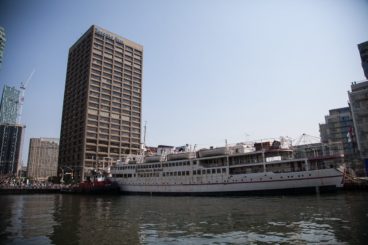
The M.S. Jadran fell into disuse in 2012 after the city disconnected its water supply amid a dispute over unpaid taxes and rent. (At last count, according to the Star, the total debt stood at $1.7 million.) “She’s not very pretty inside, that’s for sure,” Elliott said. Luckily, the hull was still in relatively good shape: the steel superstructure remained largely free from corrosion by virtue of being stored in fresh water.
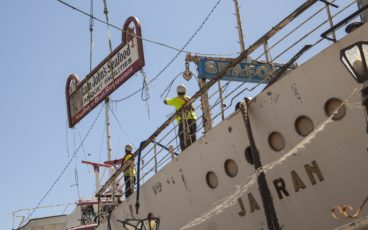
In the weeks before the move, a certified asbestos crew went through the ship securing panels that could bend during towing and release dangerous airborne particles. Objects dear to “Captain John” Letnik, including awards and press clippings, were carefully removed and handed back. Workers removed protruding objects (like the ship’s sign) to prevent anything from rubbing against the sides of the locks on the Welland ship canal during transit, and also pumped 300 tons of water into the hold as ballast to keep the top-heavy boat from capsizing.
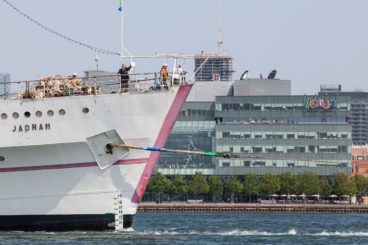
On the day of the move, two rented tugs with a combined 3,000 horsepower pulled the Jadran backwards out of its Yonge Street slip, using ropes attached to the points where the ship’s anchors used to hang.
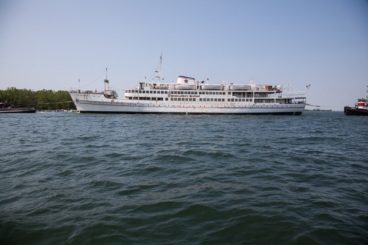
The tugboats gently rotated the M.S. Jadran, then positioned themselves in front of and behind it. The single-engine front tug provided forward power and steering while the one at the rear, a twin-engine model, used its reverse power to slow the rig down.

The Jadran left the Toronto Harbour for the last time through the Eastern Gap, the water channel between the Toronto Islands and the Port Lands. In accordance with international maritime rules, a black diamond shape was flown on the masthead, indicating to nearby vessels that the Jadran was being towed.

Out on the lake, the Marine Recycling crew treated Letnik to a lobster lunch. In total, the trip across Lake Ontario took about five hours.
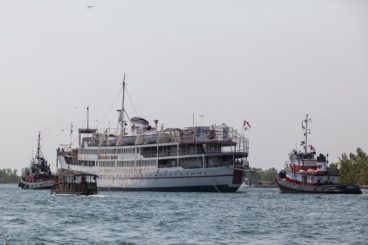
In Port Colborne, at the southern end of the Welland canal, Marine Recycling will carry out a full environmental assessment on the ship at its own facility. Electrical wiring, gasket material, and paints containing carcinogens will be removed, along with the remaining asbestos. Over the course of six weeks, the ship will be carefully dismantled from the top down, then sold to a recycler.






Glad too see the rust bucket at the foot of Yonge gone. Why the captain who left this boat fall into such disrepair and owes over $1 million in back taxes was treated like some kind of hero is beyond me.
Use Uber code UBERTORONTOFREERIDE to get $20 off your first ride. Just download the Uber app and enter the code. Valid anywhere in Canada.
I’m glad to see it gone, and equally baffled at the celebrity status assigned a man who was stubbornly running an unprofitable business into the ground at the expense of taxpayers. Add to that the fact this business was a dated, cheesy example of one of the worst 50’s-style tourist traps, and the wtf’s go through the roof. We ate there once back in the 80’s and it was awful. Someone described it as Captain Highliner at tourist prices, and they weren’t far off.
See? I can’t even read a bittersweet feel-good piece about the salvage moving company without thinking about that plate of cheap complimentary cold cuts warming on that buffet table. Ech. Thanks for getting it out of there safely and successfully, Wayne.